Letko Brosseau
Veuillez sélectionner votre région et votre langue pour continuer :
Please select your region and language to continue:
We use cookies
Respecting your privacy is important to us. We use cookies to personalize our content and your digital experience. Their use is also useful to us for statistical and marketing purposes. Some cookies are collected with your consent. If you would like to know more about cookies, how to prevent their installation and change your browser settings, click here.
Electricity Generation
Net-Zero Research Series - Part 2
Welcome to the second installment of our Net-Zero Research Series, a collection of insights from our Climate Change Committee. The series will explore various topics, including the science behind climate change, the largest sources of emissions, and the potential pathways to mitigating global warming. We will take a deep dive into the concepts and implications of transitioning to a world in which greenhouse gas emissions are balanced by achieving a net zero goal and will share conclusions informing our investment analysis and portfolio strategy.
Our Climate Change Committee plays an active role in identifying investment risks and opportunities arising from climate change, both in our portfolios and, more broadly, in capital markets. Comprised of a cross-section of our firm’s portfolio managers and investment professionals, the Committee conducts climate change scenario analysis. This entails examining potential global physical changes and how they, in-turn, impact the macroeconomic environment, government policy, regulation, sector and industry dynamics, and individual company performance.
Our role as investment manager is multilayered. On the one hand, we want to participate in efforts to limit global warming through company engagement and be at the forefront of socially responsible investments. On the other hand, it is important we remain clear-eyed and fully understand the economic, scientific, social, and political implications of the transition to a lower-carbon economy, all while fulfilling our fiduciary duty to earn a sustainable return on your investments.
In this second report, we will explain the main sources of emissions from electricity generation, the technologies that exist today to reduce these emissions and the solutions required to reduce them to zero by 2050. Click here to see what the Net-Zero Research Series covered so far.
Electricity Generation: the world’s biggest source of emissions
Electricity and heat generation is responsible for almost one-third of global greenhouse gas (GHG) emissions (Chart 1).
Global Greenhouse Gas Emissions (by Source)
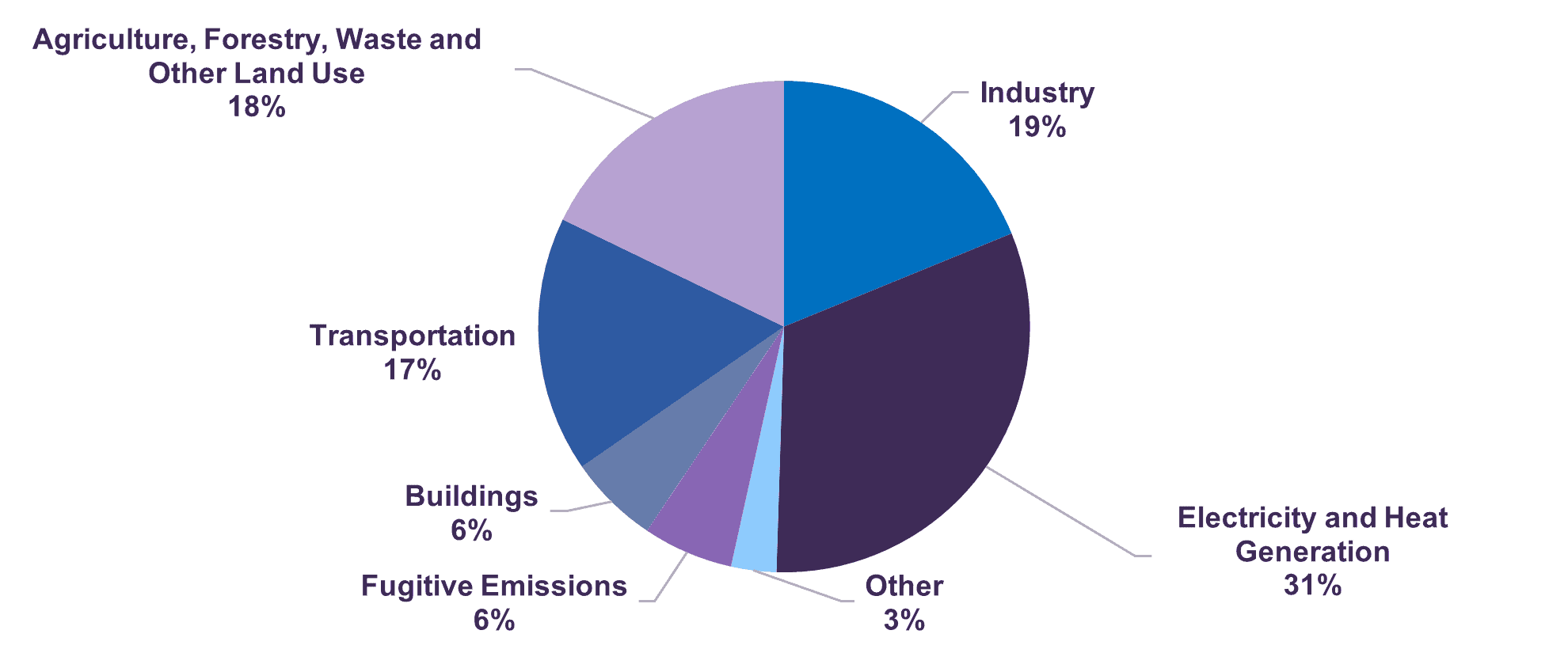
Power generation plays a critical role in society and is responsible for lighting, heating, cooling, refrigeration, running home appliances and electronics, powering public transit and operating factories.
In fact, a strong positive correlation exists between electricity consumption per capita and GDP per capita (Chart 2).
For example, electricity consumption per capita in Canada is about a third higher than in the U.S., three times higher than in China, fifteen times higher than in India, and a hundred times higher than in Afghanistan or Nigeria. This phenomenon is a direct consequence of our high GDP per capita, colder climate, and resource-intensive industries.
The reason is rather intuitive: an economic development that leads to higher living standards is impossible without a reliable supply of inexpensive electricity. A country looking to increase prosperity must provide its population with reliable and affordable electricity that can power infrastructure, households, schools, hospitals, manufacturing plants, offices, and government buildings.
Since 1990, global electricity consumption has grown at an average annual rate of 2.8%[1], closely matching global real GDP growth. Today the world consumes 27,000 terawatt-hours (TWh) of electricity annually with China at 7,500 TWh (28% of total), the United States at 4,400 TWh (16% of total), Europe at 2,700 TWh (10% of total), India at 1,600 TWh (6% of total) and Japan at 1,000 TWh[2] (4% of total). If the world were to generate all its electricity by burning wood, global forests would be gone in just two years. As the world works to reduce emissions and transition away from the burning of fossil fuels for electricity, the significant amount of energy required each year speaks to the need for any new generating technologies to be scalable.
Electricity consumption per capita vs. GDP per capita
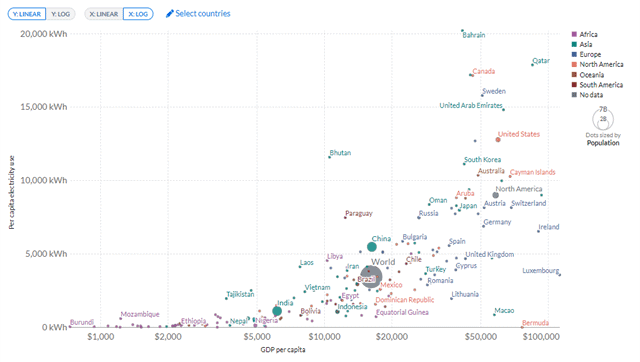
To put the scale into perspective:
Estimated Zero-Emission Generation Capacity Required to Meet Current Demand
| Electricity Source | Nuclear Power | Onshore Wind | Solar Power |
| Capacity Required | 3,200 nuclear reactors (compared to today’s 443) | 3 million wind turbines |
30 million solar panels covering roughly 220 million acres |
| Increase compared to today’s capacity | 7.2x increase over current levels | 13x increase over current levels |
13x increase over current levels |
What are the main sources of emissions specific to this industry?
Despite a push toward renewable energy in the last twenty years, only 8% of global electricity is produced using wind and solar. If we add hydro, nuclear, geothermal and biomass, a total of 37% of global electricity is produced using non-fossil fuel sources. This means 63% of global electricity (Chart 3) is still produced using fossil fuels, such as coal, natural gas, and oil. This generation is responsible for 14 billion tons of the total 36 billion tons of global GHG emissions each year, with 10 billion tons deriving from coal, 3 billion tons from natural gas and 1 billion tons from oil.
Global Electricity Generation (by Source)
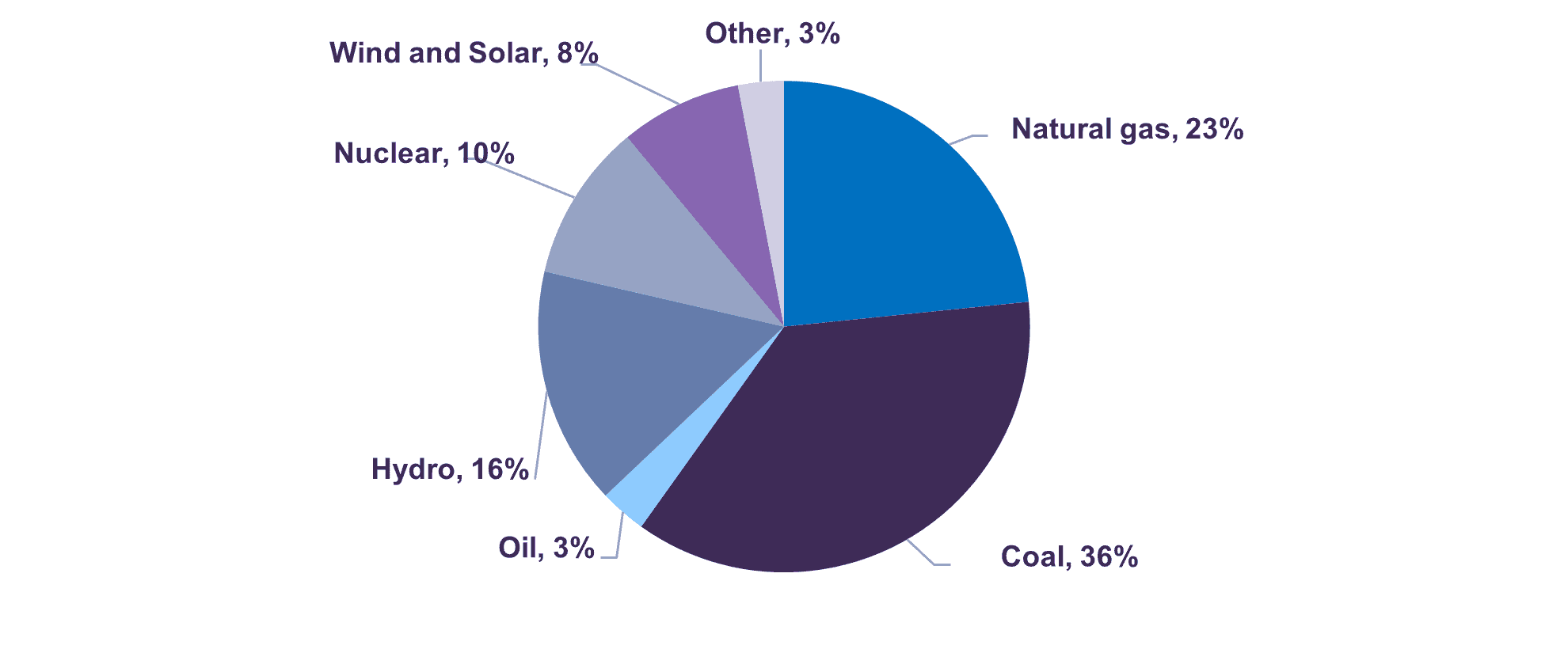
In aggregate, coal-fired generation has been on the rise, specifically in emerging markets (Charts 4 and 5) seeking inexpensive and reliable electricity for growing populations. Over the last ten years, China and India have seen coal-generated electricity increase by 67% and 94% respectively, with CO2 emissions up 2 and 0.6 billion tons respectively. This 2.6-billion-ton increase accounted for 100% of the rise in global CO2 emissions since 2009.
Today, coal accounts for 65% of electricity generated in China, 74% in India, 23% in the U.S., 14% in Europe and 31% in Japan. This contrasts with wind and solar, which account for 8% of electricity generation in China, 7% in India, 10% in the U.S., 20% in Europe, and 8% in Japan.
Global Coal-Fired Electricity Generation, TWh
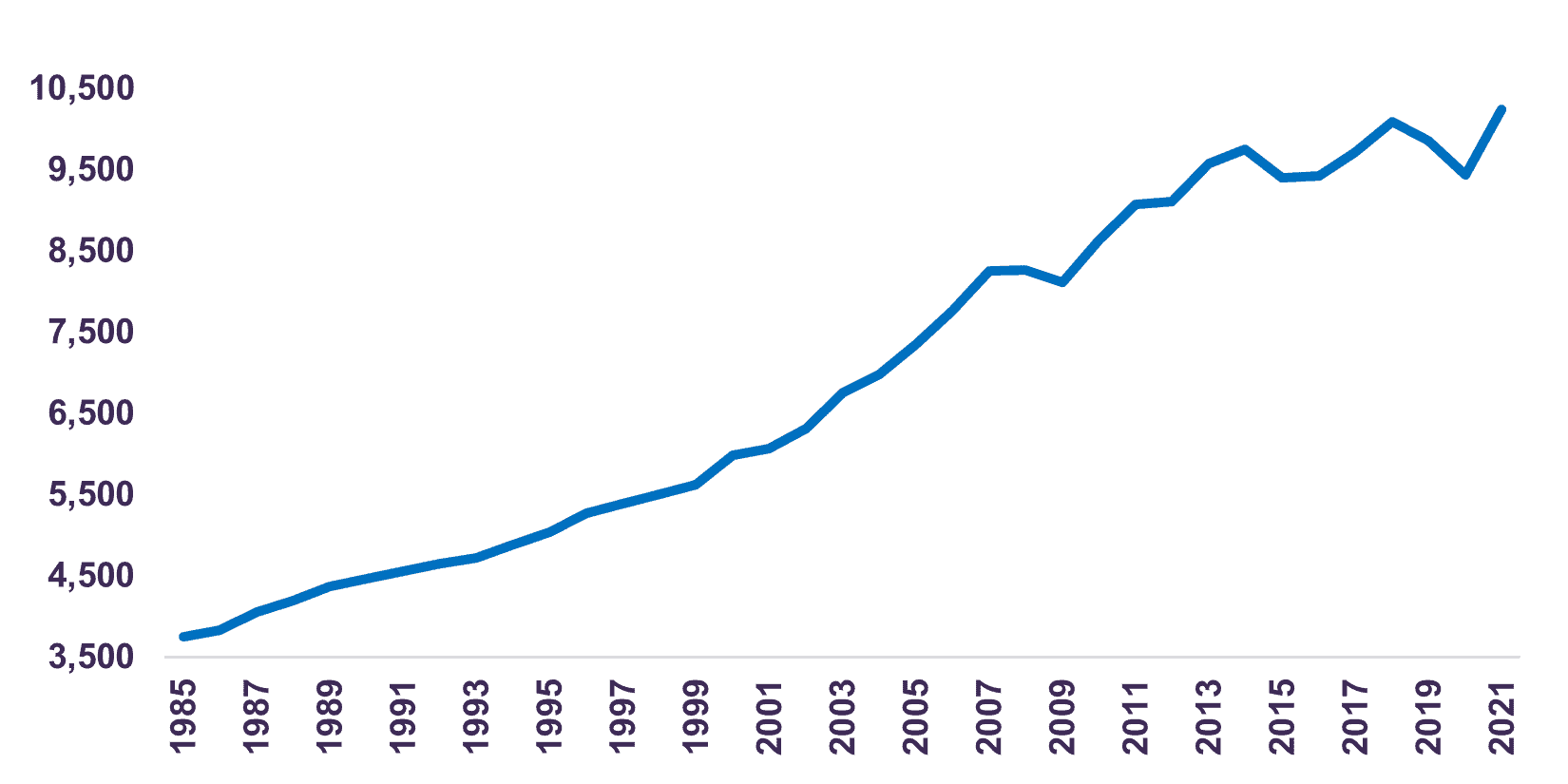
Global Coal-Fired Electricity Generation as % of Total Electricity Generation
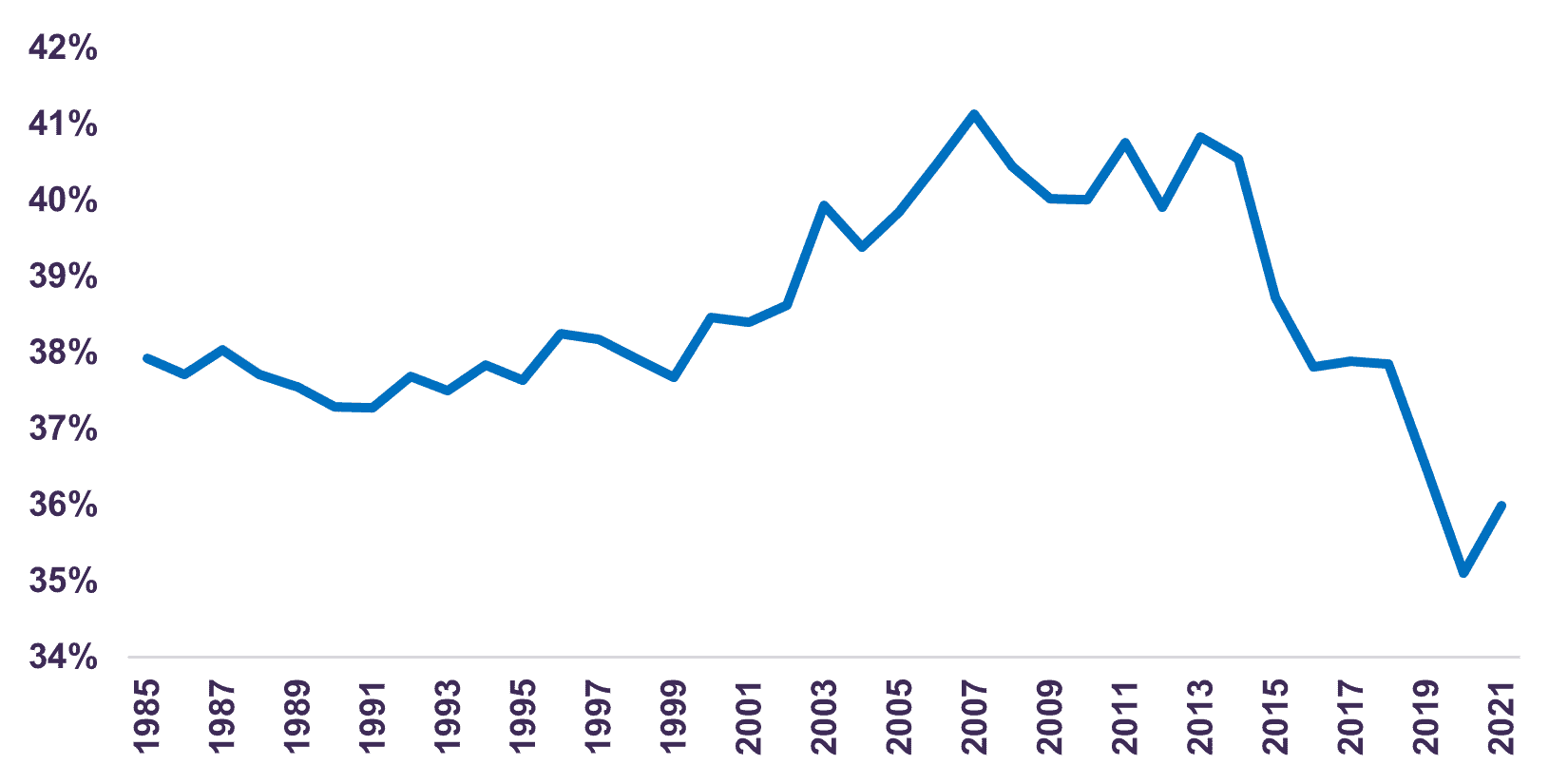
What are the basic requirements of an electricity generation network?
As countries move to reduce emissions from their electricity networks, power-generating technology must still fulfill three key criteria to meet real-world demand.
1. Scalability
Scalability is the ability to produce vast amounts of electricity. The following plants are scalable, but have some limitations:
- Combined-cycle natural gas power plants (a natural gas-fired power plant that uses both a turbine and a steam generator to produce electricity).
- Nuclear plants.
- Hydro dam facilities.
- Wind and solar farms.
Combined-cycle natural gas power plants and nuclear plants are easily scalable, provided suitable sites and fuel sources are readily available. The same can be said about hydro dam facilities, but only up to a point after which suitable locations for dams start to become sparse or too far away from electricity demand centers. Wind or solar farms are also scalable, provided you have adequate locations. However, these technologies also suffer from intermittency when the wind slows, or the sun doesn’t shine. Today, this is solved by having an alternate baseload electricity source, typically powered by fossil fuels. In a net-zero world, these baseload sources would be displaced by utility-scale batteries, capable of storing a day’s worth of electricity to power a city or town. This battery technology is not yet scalable, in fact, batteries installed on electricity grids rely on the same chemistry as laptop (computer) batteries and can only provide up to four hours of power demand on a small scale. Therefore, for scalability standards to be met, new technologies need to provide electricity at the same level as today’s natural gas and nuclear power plants.
2. Reliability
Reliability refers to the need for a steady uninterrupted supply of electricity 24 hours a day, 7 days a week, 365 days a year, so hospitals, factories, and households do not experience service interruptions due to power outages. Today’s power grids count on fossil fuel-fired, hydro, and nuclear power plants to provide a consistent baseload supply of electricity. As discussed above, wind and solar are intermittent sources of electricity and as such do not meet the reliability criterium, until a scalable battery solution is developed.
Relative Affordability of Electricity Generation Plants
| Type | Nuclear and hydro power plants | Coal and natural gas-fired plants |
Solar and wind farms |
| Construction Cost | Expensive to build | Less expensive to build | High upfront build cost |
| Operating Cost | Cheap to run | Higher operating costs | Minimal maintenance expenses |
| Notable Traits | Once built, runs for a long time. Site specific (geographic features, safety) | Higher emissions. Requires constant supply of fuel (Coal or natural gas) | Intermittent generation and requires the use of baseload power or energy storage |
3. Affordability
Affordability speaks to the price of electricity. Table 2 describes the relative affordability of each category of electricity power plants.
It is important to think in terms of the overall power grid cost as opposed to costs for each individual power plant. Transitioning to net-zero will not succeed if it leads to massive increases in electricity costs that will permeate the economy, lead to inflation, and lower our standard of living. New technologies will need to be affordable for countries and for its citizens.
These three criteria combined are the reason for today’s electricity fuel mix. Fossil-fuel-based power plants and hydro facilities are relatively scalable, reliable, and affordable. Nuclear, although scalable and reliable, is not very affordable if built new, carries safety concerns and results in waste disposal and decommissioning issues. This explains why nuclear power has not gained more popularity since the initial wave of installations in the 1960s and 1970s. Wind and solar farms have come a long way to improve their affordability and scalability, but still suffer from intermittencies. Thus, the necessity of various government support schemes to promote their proliferation. Any changes to the fuel mix in order to reduce overall emissions levels must continue to meet these three criteria.
Importantly, as energy transition unfolds and society looks to reduce emissions through electrification, through electric vehicles or electric furnaces, the amount of electricity generation required will increase. This is why it is imperative to decarbonize electricity generation in a viable and sustainable way that is scalable, reliable, and affordable.
How does the current industry commit to reducing the sector’s emissions while remaining in line with Net-Zero principles?
Most countries have committed to reaching zero GHG emissions by 2050. This includes emissions from the electricity generation sector, inciting regulators, electric utilities and power plant operators to start taking steps to reduce their carbon footprint over time. For example, many U.S. utilities have committed to reducing their CO2 emissions by 40%, and even up to 50% by 2030, compared to 1990 base levels as an intermediate target. Furthermore, some countries like Germany, and states such as California have accelerated net-zero targets for 2045. On the other hand, China and India will take until 2060 and 2070, respectively, to reach net-zero, as their high reliance on coal-fired power generation will make the transition more difficult in the absence of affordable alternatives.
Many utilities in the U.S. are well on their way to reaching the 40% GHG emission reduction target vs. 1990 base levels, given that they have been shutting down their coal plants and replacing them with a combination of natural gas plants, wind farms and solar facilities. In fact, this has been the primary strategy for utilities to reduce carbon emissions, because a typical natural gas plant produces 60% less CO2 per megawatt-hour of electricity than a typical coal plant.
Interestingly, increasing the share of renewables in the electricity grid is a delicate endeavor. This is because shutting down coal and natural gas plants reduces baseload and flexible generation that provides electricity when the sun does not shine and when the wind is weak. In other words, renewables alone cannot provide a reliable supply of electricity to meet demand 24 hours a day, 7 days a week, 365 days a year. Therefore, net-zero in electricity will not be achieved with renewables only. Large-scale battery storage able to back up one or even several days of daily electricity demand is an absolute requirement to ensure the grid remains reliable, no matter the weather or time of year.
What solutions are available today?
Reducing CO2 emissions from electricity generation is a multi-layered endeavor. The following options are solutions applied today and for the future.
1. Improving efficiency and reducing consumption:

Source: image used under license from Shutterstock.com
Improving efficiency and reducing consumption is the most feasible first step any country can take today. Developed countries have already reduced their electricity intensity of GDP and are seeing flat or declining demand. This is achieved by using LED lighting, automatic switches, replacing old inefficient furnaces with new efficient ones, and continuously improving manufacturing operations to reduce power intensity. On the other hand, emerging markets continue to see strong growth in electricity demand bolstered by faster GDP growth, industrialization, and better standards of living. This goes to show that efficiency is a good first step but has limits to how much emission reduction it can achieve, especially in emerging markets, where keeping up with growing demand is the priority.
2. Transition from coal to natural gas:
The next step to reducing emissions is to shift away from coal and move towards natural gas, a transition that would reduce CO2 emissions by 60%. The United States is an excellent example of how natural gas can be used as a transition fuel. While natural gas is a hydrocarbon and burning it does release CO2 into the atmosphere, it is the least carbon-intensive fossil fuel. Unlike coal, it produces no other health-damaging emissions such as acid rain causing sulfur oxides (SOx) and nitrogen oxides (NOx) or respiratory disease-causing particulate matter. Since 2009, the United States has seen its coal-fired generation down 45%, reducing CO2 emissions by 0.8 billion tons, while natural gas-fired generation is up 72%, increasing emissions by only 0.3 billion tons[3]. This is an example of how the U.S. has managed to decrease its CO2 emissions from power generation by a net 0.5 billion tons, while at the same time significantly reducing smog and heath-damaging particulate matter. If China and India, with a combined release of 6 billion tons of CO2 from coal-fired generation, were to shut down their coal-fired plants and replace them with combined-cycle natural gas power plants, they would reduce their carbon emissions by 3.6 billion tons, or 10% of the global total.
3. More hydro and nuclear power plants:
An emission-free, but costly way, to displace coal would be to build more hydro and nuclear plants. While there are justifiable safety concerns about nuclear power following well-known accidents such as Chernobyl, Three Mile Island and Fukushima, it continues to be a reliable and scalable technology whose high upfront cost is partially mitigated by lower operating expenses. Hydro power is relatively clean, but requires flooding extensive lands and is location dependent, often requiring long transmission lines to bring power to demand centers. Given that these technologies are emission-free, each country will decide for itself how much hydro and nuclear capacity to add in the future to help with energy transition. For example, today France is comfortable relying on nuclear power plants for 70% of its electricity, while Brazil’s hydro accounts for 70% of its power needs. In contrast, Canada relies on hydro for 58% of its electricity production and on nuclear for 15%, while the U.S. reliance on hydro and nuclear is 6% and 19% respectively[4].
4. More wind and solar farms:
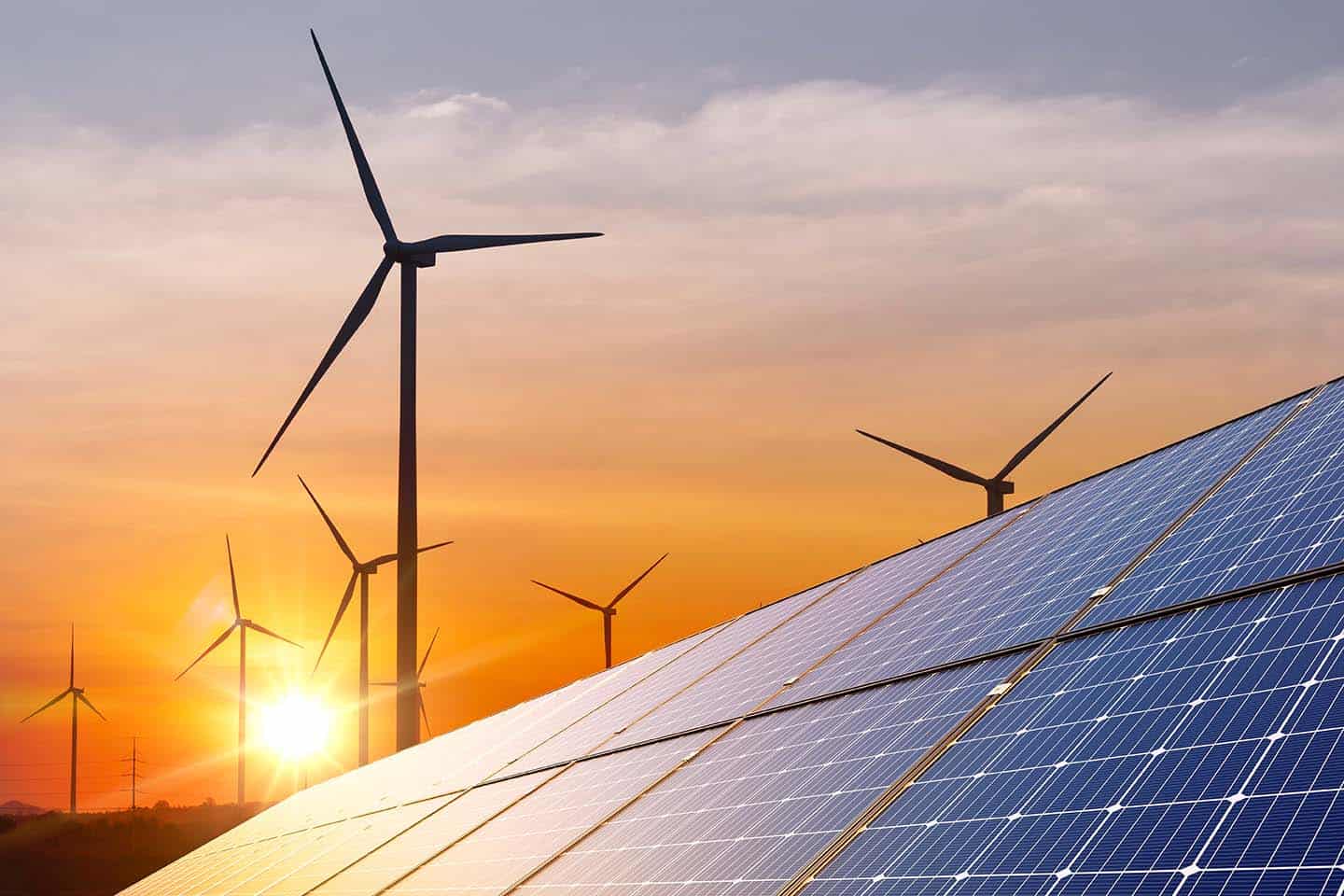
Source: image used under license from Shutterstock.com
Increasing the number of wind and solar farms is another strategy to deploy on the road to net-zero. Much like real estate, they are both location dependent. An onshore wind turbine located in West Texas or Southern Alberta generates more than twice the electricity than one located in Ontario or the interior of France. By the same token, a solar farm situated near Las Vegas or Phoenix generates more than four times the electricity than one situated in cloudy Vancouver or rainy Manchester. Solar is only available for six to ten hours per day depending on geographical latitude and time of year (i.e., more solar resource available in summer than in winter). It is also subject to unpredictable daily changes in cloud cover. Wind is highly variable depending on the time of year (more in winter, less in summer) and the time of day (more at night, less during the day). In any given month, the lowest amount of wind output is often just a third of the highest.
While both wind and solar are emission-free, they suffer from intermittency and therefore will not get us to net-zero without scalable and affordable batteries. Today’s batteries are still the 1970s vintage of technology used in laptops and cannot be developed and deployed at scale or at a reasonable cost. Nevertheless, even without batteries, wind and solar can piggyback on existing baseload technologies such as natural gas, coal, nuclear and hydro to provide up to 25% of a country’s electricity needs. Anything more than that destabilizes the grid frequency and requires a vast installed base of flexible generation, most often peaking natural gas plants (simple cycle turbines that can rev up within 15 minutes like jet engines), to ramp up output when renewable production is low and quickly ramp down when this output is high. Furthermore, building too much wind and solar capacity leads to higher overall electricity prices because baseload and peaking capacity cannot be eliminated, as exemplified by California and Germany where high wind and solar penetration has been accompanied by sky-high power tariffs.
New technologies are needed to get to Net-Zero
Four steps, efficiency improvements, switching from coal to natural gas, building out more nuclear and hydro plants, and increasing the share of wind and solar are viable options today. However, they are insufficient in getting us to net-zero. To eliminate all CO2 emissions released from the electricity generation sector, new technologies will need to advance their scalability and cost competitiveness.
If we are to achieve net-zero, we believe the following solutions will have to become scalable, affordable, and reliable:
1. Batteries:
Utility-scale electricity storage solutions are massive batteries capable of storing a day’s demand for energy of a town or a city. They would replace the need for baseload power when using wind and solar electricity generation by discharging when renewable generation is low, and recharging when renewable generation is high. This smooths out the capacity for renewables to provide electricity to the grid and overcomes the intermittency challenges inherent with wind and solar. This application’s scalability, affordability and reliability has improved dramatically over the last decade and will go a long way in allowing wind and solar to stand on their own two feet without needing support from legacy technologies, such as gas or coal-fired power plants.
2. Carbon capture, utilization, and storage (CCUS)[5]:
This solution refers to a suite of technologies involving the capture of CO2 from large energy sources (e.g., power generation, industrial facilities) or directly from the atmosphere. The captured CO2 is compressed and transported by pipeline, ship, rail, or truck to be used in a range of applications or injected into deep geological formations, trapping the CO2 for permanent storage[6].
This technology could be an important carbon sink that deals with unavoidable emissions. For example, natural gas-fired power plants are very useful for electricity grids with a lot of renewables, because they provide both baseload and peaking power at a moment’s notice. CCUS allows gas-fired plants to continue running, while sequestering their CO2 emissions and rendering them zero-emissions.
Today, there are approximately 35 commercial facilities applying CCUS to industrial processes, fuel transformation and power generation. There are over 300 CCUS projects in development, with aspirations for an additional 200 new capture facilities to be in operation by 2030, which would capture an incremental 220 Mt CO2 per year. Although momentum is growing, the deployment of CCUS still remains below what is required to meet Net-Zero scenarios[7].
3. Green Hydrogen:

Source: image used under license from Shutterstock.com
Hydrogen is a universal, light and highly reactive fuel that can be used to generate electricity through combustion or through an electrochemical reaction in a fuel cell without the byproduct of harmful emissions. Most hydrogen today is sourced from natural gas, and therefore generates emissions in its production. The solution to this is known as green hydrogen, which is produced from water and zero-emission electricity through a process called electrolysis, where an electrical current is used to separate the water molecule (H2O) into hydrogen (H) and oxygen(O)[8]. The hydrogen can be stored for later use, and the remaining oxygen can be sent back into the atmosphere with no negative impact[9]. When renewable energy sources, like wind or solar, are used to power the process of electrolysis, the hydrogen production chain releases no CO2 and is considered “Green”.
Green hydrogen can be used to power vehicles, planes, ships, long-haul freight, and the production of ammonia for fertilizer[10]. Emissions-free hydrogen generated with renewable electricity could also act as a form of energy storage, similar to a battery, to support the efforts of wind and solar.
Unlike the other two solutions discussed above, electrolysis is commercially available today and can be acquired from multiple international suppliers[11]. However, for green hydrogen to become a mainstream, low-emissions source of electricity, we first need to increase the deployment of renewable electricity in order to power electrolysis. The process then needs to be scaled up and costs must come down. Today, green hydrogen costs USD $30 per Gigajoule compared to conventional natural gas priced at USD $3 per Gigajoule. As the cost of wind turbines, solar panels and electrolysers declines over time, so will the cost of green hydrogen.
It is important to note that these three technologies today are not yet scalable or economic. Governments and companies worldwide have been and will continue to support their development to see further progress.
In addition to the solutions discussed above, other technologies will evolve and improve over time and perhaps some becoming even more effective and economic than the aforementioned three. For example, nuclear fusion has been making steady progress over the years, but always seemed elusive. However, in December 2022 U.S. scientists managed to get more energy out of their nuclear fusion experiment than they put in. Fusion still has a long way to go before becoming a commercial technology providing electricity to the grid, but we are excited about its prospects. Furthermore, several countries such as Canada, the U.S., India, and Poland are experimenting with small modular nuclear reactors (SMRs). Time will tell if miniaturized nuclear could be one of the solutions to achieving net-zero.
Achieving Net-Zero is a bespoke endeavor
Going forward, energy transition means global electricity demand will grow faster than it has in the last 20 years. Electric vehicles, hydrogen electrolysers, electrification of heating and industrial processes will all require more electricity in a step change not seen before. For example, our calculations show the U.S. would need to double its electricity production to replace the energy currently generated by oil and natural gas.
At the end of the day, achieving net-zero will be a country-specific endeavor. The countries endowed with prolific hydro, wind and solar resources can do more in these renewable areas compared to those that are not. For example, Southern Spain or Northern Mexico are ideal for solar generation, while Inner Mongolia in China or Central Oklahoma are perfect for wind generation.
Additionally, security of energy supply plays an important role in each country’s decision making. Countries prefer to be as self-sufficient as possible in energy needs and reduce the reliance on other countries or potentially volatile global commodity markets for supply. For instance, China is mostly self-sufficient in coal, but imports 50% of its natural gas[12], therefore a transition to gas-fired plants may not be preferred. Many countries are reluctant to install nuclear power plants because they would need to import uranium fuel rods used to produce electricity. Installing wind and solar may not appear as productive if a country does not manufacture any wind turbines or solar panels themselves.
Furthermore, the wealthier a country, the more it can afford to push through technologies that increase electricity prices. German households pay USD $0.30 per kWh[13], a rate unaffordable for most emerging market households. In addition to being ubiquitous and cheap, a coal-based source of electricity is the most pragmatic choice for countries with low incomes, in need of low-cost and reliable sources of electricity. After all, reliable baseload power allows children to go to well-lit and heated schools, allows hospitals to operate properly, and supports the creation of a competitive industrial economy.
Developed countries are expected to lead the way in reducing electricity-related CO2 emissions. Public concern for climate change is high[14] and wealthier countries can afford to invest more in the transition towards net-zero. Of course, there are limits to what even a wealthy consumer can handle. The recent run-up in electricity prices in Europe is a good example. Meanwhile, emerging market countries will pursue a pragmatic policy of providing vital, reliable, and cheap electricity to their people. Any solution that comes with a higher price tag will need to be subsidized by developed countries. The hope is that various technologies such as utility-scale batteries, carbon capture, utilization, and storage, as well as green hydrogen will become more scalable and affordable over time, resulting in a virtuous self-fulfilling switch away from coal and natural gas.
How does this inform our portfolio strategy?
At Letko Brosseau & Associates, we take great interest in how companies are navigating through the energy transition. We believe the greatest impact is achieved when a company with a high emissions profile changes its power generation mix and becomes a low emitter. As shareholders, we can provide the encouragement and support that many companies need to succeed in a capital-intensive endeavor of shutting down coal-fired power plants and building new, clean power facilities.
When making portfolio decisions, we are guided by several principles.
Every country and company will have their own tailored approach to reducing carbon emissions. No single approach should be mandated or pursued because geographic, economic, and societal circumstances differ.
The biggest impact is made when a company with high GHG emissions and intensity succeeds at lowering them, thereby extending its social license to operate, and often lowering its costs.
We strongly believe natural gas will continue to play a vital role in enabling the energy transition away from coal, while supporting wind and solar solutions.
When selecting companies for our portfolios, we want to see good environmental stewards who care about their communities and their impact on the climate. We do not shy away from companies that, due to historical circumstances, have higher emissions, if tangible and sustainable plans to reduce their carbon footprint are laid out and executed.
What are great company examples?
Two companies mentioned below have successfully overhauled their original power generation mix, while simultaneously growing their earnings and dividends, as well as deleveraging their balance sheets, all without any special government help or subsidies. Going forward, they will continue to lead the way in new wind and solar installations, serving their respective markets with clean, reliable, and affordable electricity.
Capital Power
We have been long-term investors in Capital Power, an Alberta, Canadian-based operator of power plants.
As recently as 2009, the company relied on coal for 80% of its electricity production given the historical circumstances of energy development in Alberta (i.e., Alberta has been endowed with vast shallow deposits of coal exploited to generate reliable electricity).
Over the last decade, and especially in the last five years, the company is on track to become coal-free by 2024, having achieved a remarkable transition of lowering their GHG emissions by more than two-thirds.
Capital Power is a good example of a company that had to overcome significant historical and geographical obstacles to transition from coal to a combination of natural gas and renewables.
Energias de Portugal (EDP)
EDP is a Lisbon-based company with a mix of power generation and regulated electric grid assets across Iberia, North America, and Brazil.
The company’s renewables share of capacity was just 20% in 2005 but has risen to 70% today and will get to 90% by 2030 as the company goes completely coal-free.
EDP, acting as an incumbent hydro power generator in Portugal and Spain, used its position as a springboard to grow its low-carbon power generation business around the world, thereby contributing to the overall reduction in GHG emissions well beyond its home market.
Conclusion
Reducing emissions from electricity generation is not a simple or quick endeavor. Energy efficiency measures are a good starting point to eliminate waste and avoid unnecessary emissions. Next, switching from coal-fired to natural gas-fired plants reduces CO2 emissions by two-thirds, while also eliminating smog and particulate matter. Building new hydro and nuclear power plants is another solution available today, albeit comes at a higher cost and requires societal buy-in. Adding renewables such as wind and solar farms to the mix leads to an even greater reduction in GHG emissions. As technology improves, power companies will begin to incorporate more utility scale battery storage solutions that will allow them to store renewable power and use it at times when the sun does not shine, or the wind does not blow. Also, carbon capture, utilization and storage could play an important role in reducing emissions where the use of natural gas or coal cannot be avoided. Finally, zero-emission green hydrogen has the potential to one day become scalable and affordable, making it an ideal fuel that could displace natural gas and make achieving net-zero a reality.

Victor Swishchuk, CFA®
Portfolio Manager, Partner
Prior to joining Letko Brosseau & Associates, he was a Vice-President, Interest-Rate Trading with TD Securities.
At the firm, he is responsible for Energy and Utility Investments and co-manages the Infrastructure Equity Fund.
Mr. Swishchuk is passionate about getting to know companies and their management teams, as well as analyzing the ever-changing currents in global energy.
[1] BP Statistical Review of World Energy 2021. https://www.bp.com/content/dam/bp/business-sites/en/global/corporate/pdfs/energy-economics/statistical-review/bp-stats-review-2021-full-report.pdf[2] BP Statistical Review of World Energy 2021. https://www.bp.com/content/dam/bp/business-sites/en/global/corporate/pdfs/energy-economics/statistical-review/bp-stats-review-2021-full-report.pdf
[3] US Energy Information Administration
[4] BP Statistical Review of World Energy 2021
[5] https://www.iea.org/reports/carbon-capture-utilisation-and-storage-2
[6] https://www.iea.org/reports/carbon-capture-utilisation-and-storage-2
[7] https://www.iea.org/reports/carbon-capture-utilisation-and-storage-2
[8] https://www.weforum.org/agenda/2021/12/what-is-green-hydrogen-expert-explains-benefits/
[9] https://www.petrofac.com/media/stories-and-opinion/the-difference-between-green-hydrogen-and-blue-hydrogen/#:~:text=Green%20hydrogen%20is%20hydrogen%20produced,need%20electricity%2C%20we%20need%20power.
[10] What is green hydrogen, and how green is it, anyway? Frances Willick · CBC News · Posted: Dec 11, 2022 5:00 AM EST https://www.cbc.ca/news/canada/nova-scotia/green-hydrogen-what-is-it-how-green-is-it-1.6587802
[11] What is green hydrogen and why do we need it? An expert explains. Dec 21, 2021https://www.weforum.org/agenda/2021/12/what-is-green-hydrogen-expert-explains-benefits/
[12] BP Statistical Review of World Energy 2021
[13] German Association of Energy and Water Industries (BDEW) 2021
Where the information contained in this presentation has been obtained or derived from third-party sources, the information is from sources believed to be reliable, but the firm has not independently verified such information. No representation or warranty is provided in relation to the accuracy, correctness, completeness or reliability of such information. Any opinions or estimates contained herein constitute our judgment as of this date and are subject to change without notice.
This presentation may contain certain forward-looking statements which reflect our current expectations or forecasts of future events concerning the economy, market changes and trends. Forward-looking statements are inherently subject to, among other things, risks, uncertainties and assumptions regarding currencies, economic growth, current and expected conditions, and other factors that are believed to be appropriate in the circumstances which could cause actual events, results, performance or prospects to differ materially from those expressed in, or implied by, these forward-looking statements. Readers are cautioned not to place undue reliance on these forward-looking statements.
Concerned about your portfolio?
Subscribe to Letko Brosseau’s newsletter and other publications:
Functional|Fonctionnel Always active
Preferences
Statistics|Statistiques
Marketing|Marketing
|Nous utilisons des témoins de connexion (cookies) pour personnaliser nos contenus et votre expérience numérique. Leur usage nous est aussi utile à des fins de statistiques et de marketing. Cliquez sur les différentes catégories de cookies pour obtenir plus de détails sur chacune d’elles ou cliquez ici pour voir la liste complète.
Functional|Fonctionnel Always active
Preferences
Statistics|Statistiques
Marketing|Marketing
Start a conversation with one of our Directors, Investment Services, a Letko Brosseau Partner who is experienced at working with high net worth private clients.
Asset Alocation English
 Canada - FR
Canada - FR U.S. - EN
U.S. - EN